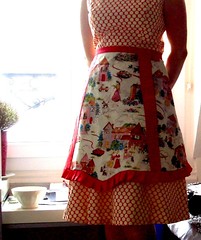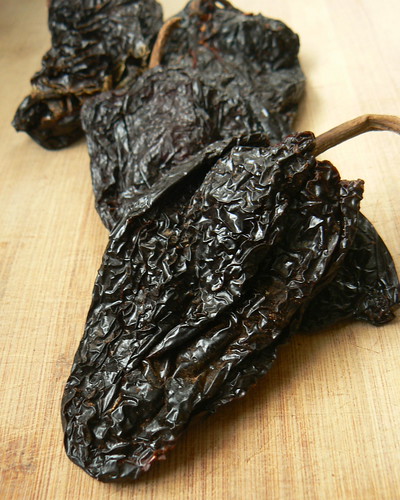
Recipe for Chorizo.
What better way to learn about culture and food than by eating sausage. In today's episode, we take a little trip South of the border as I try to understand how two cultures came together to make this magical mixture, chorizo. Olé!
Chorizo is Spanish for sausage, and there are many kinds of chorizo ranging what we know as fresh chorizo, to Chorizo Verde, to a dry cured Spanish chorizo. In America we are most familiar with the fresh Mexican rojo (red) chorizo, a salty spicy sausage that comes in long pakages. My favorite way to eat it is for breakfast fried up in a hash with peppers and potatoes. But the store packaged stuff is nasty, I want a recipe that uses few ingredients and tastes like chorizo.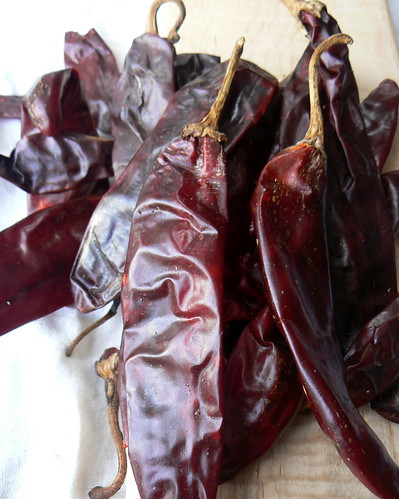
Chile Paste and the Aztec Blender.
The primary flavor for the chorizo is the chile (or chilli, or chili, or pepper). While I have made sausage in the past by just using powdered peppers, I believe you get a better flavor by preparing a chile paste from dried peppers. Here's how I learned to do it in school: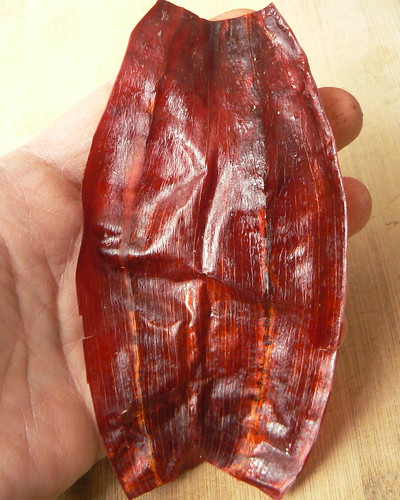
Remove the stems and seeds from the chiles.
Blanch them in oil. No more than five seconds (really three), or they will they will burn, you'll get the hang of it. Make sure the oil is no more than 350F. Strain and save the chile oil.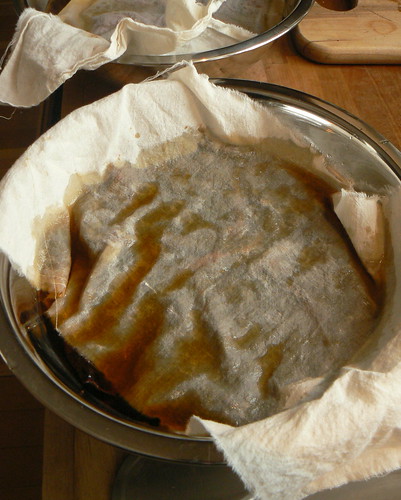
put the blanched chiles in hot tap water, cover with a paper towel and let them hydrate for ten minutes.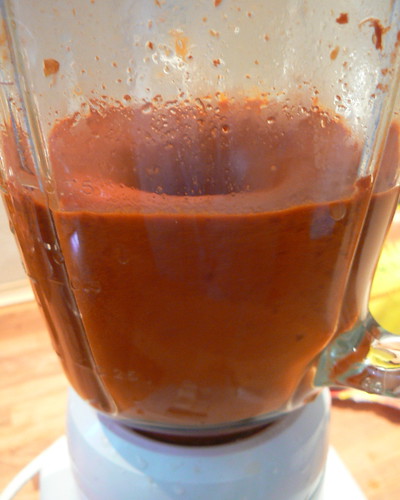
Discard the hydrating water, put the chiles in a blender, add about a cup of water (I started with 3oz (90g) of chiles) and puré. Strain the mixutre.
If you watch a lot of Rick Bayless, you might have noticed that the blender gets used a lot in the Cocina Mexicano.I have often wondered how did this stuff get made before the modern miracle of the West Bend. The Matate made it all possible. It's the three legged grinding stone that for centuries has been in the center of the Mexican kitchen. Up until the turn of the twentieth century a woman in the campesino would spend a third of her life grinding food (corn mostly) on the Matate, "The bitter black stone." Check out ¡Que vivan los tamales!: Food and the Making of Mexican Identity, by Jeffrey Pilcher for a history of the Mexican kitchen.
The meat of the matter.
So you've got your flavorful chile paste what about the meat? Before the Spanish showed up, there wasn't much meat in the Mexican diet, just turkey, iguana, insects and of course fish. With the conquistadors came Mestizo cuisine, a mixture of the two cultures, the Spanish introduced pork, beef and chicken along with rice, garlic and onion. The Spanish also introduced the art of making sausage. I read in Diana Kennedy's book, My Mexico: A Culinary Odyssey with More Than 300 Recipes, "Cortes introduced cattle and pork into the valley (Toluca, famous for sausage...(and) Spanish techniques for sausage making and pork curing naturally followed."
Okay so we have the Mexican Spanish food connection. Let's illustrate it in sausage.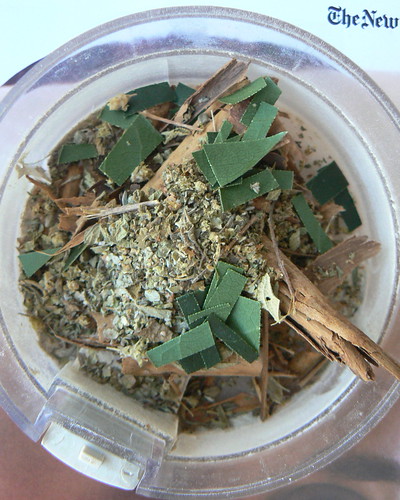
Herbas de olor.
Like the bouquet garni of French cooking, Mexican cuisine has amomatic herbs that serves as a seasoning base: Bay, thyme and marjoram make up the herbas de olor. In some Mexican groceries you can find these three fresh bunched together. I found these herbs in several Chorizo recipes so we will use a little bit. I would recommend trying to find fresh bunches, but in my final recipe I ended up using some dried. I also used some Mexican oregano (because I had some), if you don't have it I wouldn't worry about it too much. Mexican Oregano is not a part of the oregano/marjoram family it's actually related to Lemon Verbena.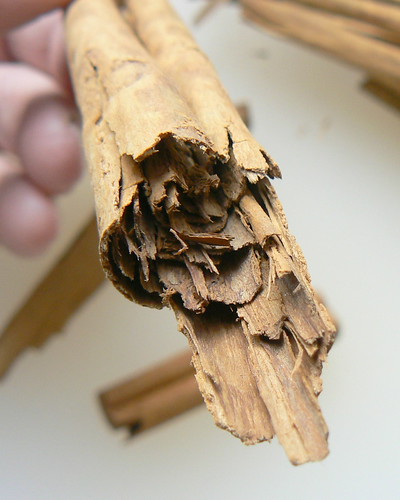
Canela - Cinnamon.
I have known for some time that what we typically call cinnamon is actually cassia, but I hadn't known the difference. In addition when I read recipes calling for "Cinnamon, preferably Mexican" I figured there's a third version from South of the border. Mexican cinnamon is actually true cinnamon and it's imported from Asia. The difference between cinnamon and cassia is dramatic: Cassia is blunt, cinnamon is light and sophisticated. Don't get me wrong, I wont be giving up my cassia for my cinnamon buns, but using Canela, true cinnamon, in moles or chorizo makes a world of difference.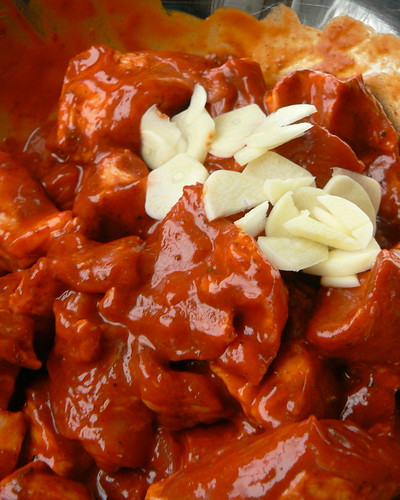
I made up two chiles pastes: guajillo and ancho. Bayless calls the guajillo the "workhorse" of Mexican cuisine, but I would guess the ancho is the most widely used. The guajillo gives beautful color, the ancho provides rich undertones, along with the spices and some garlic, I marinate the pork for an hour.
I made several batches using various combinations of ingredients, I even did a batch with added fat,but I wanted to keep things as simple as possible so I left out the added fat. In all I made about ten pounds of sausage over the past four days.


Here's the recipe:
450 g (1 lb) pork shoulder cubed
60g (2oz) Chile paste (I used 50/50 guajillo/ancho, see above for paste instructions)
2 cloves (10 g) of garlic minced.
8 g (1 teaspoon) Salt
4 g cinnamon (for cassia use less, see above)
2 fresh bay leaves minced
1 g dried thyme
1 g dried marjoram
1 g dried Mexican oregano
15 ml (1 Tablespoon) Cider vinegar
Combine cubed pork, chile paste, and garlic. Process salt, herbs and spices in a spice mill and add to mixture. After a rest, run the mass through a grinder. Kneed it adding the vinegar until it starts to come together, about one minute. Stuff into hog casings for that loganzia look.
Chorizo is cooked without a casing, use it for breakfast or for stuffing peppers or for whatever. Enjoy. I gotta get to class.
Cheers.
25 February, 2009
Chorizo
15 February, 2009
09 February, 2009
Kick it to the Curb Tony: My Southside Ain't Gritty

Once again someone from the national media cannot resist the adjective "gritty" when saying the word "Southside." Anthony Bourdain braved our mean streets in a rented caddie for last week's episode of No Reservations. Apparently he made is back North with all his hubcaps in tact. But nobody told him he was parked in the dead guy's spot.
On the episode he visited Calumet Fisheries. I wrote about this place back in November, and last Saturday I had the chance to spend most of the day there taking pictures, talking to the people who work there and observing first hand the power of cable TV.
"I have no idea how they picked us, but this is great." That's Mark Kotlick, one of the owners of Calumet Fisheries. He spent the day gladly talking to inquisitive new customers, discussing the history of the place and showing off the fish that are smoked right outside. "We smoked a week's worth of fish and we might run out today."
Thank you Tony. 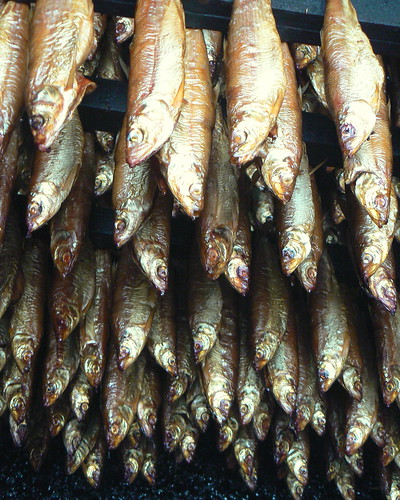
Oh yeah about the dead guy: The manager, Carlos, (who has worked there on and off since 1995, and has a Culinary Certificate from CHIC) told me his story: "I come in one morning and there's a car parked out front, there's usually no cars here, and I notice there's a guy in there. Sleeping. After a few minutes I decide it's time for him to move along and I tap on the window. Nothing. I beat on the window, and I yell and still nothing. Now I'm starting to get a bad feeling. I call 911. A cop shows up, I don't know his name but I recognize him, he opens the door, put his fingers on the guy's neck, then closes the door. The cop says "Yep he's dead. You got any smoked chubs?"
To the guys at Calumet, thanks for letting me spend the day with you, I'll get the photos to you soon.
A different kind of Southside, Pilsen.
If Tony had been a really lucky travelling TV personality, he would have ended up where I was on Sunday, Pilsen. This quarter at Kendall I have Cuisine of Mexico class, and Chef took us on a field trip. 
We visited World Wide Produce at the Chicago International Produce Market Then we went to Cermak Produce Which is a beautiful store, not gritty at all. 
Then Chef led us to El Milagro for fresh masa. We all got a turn feeding the masa machine. 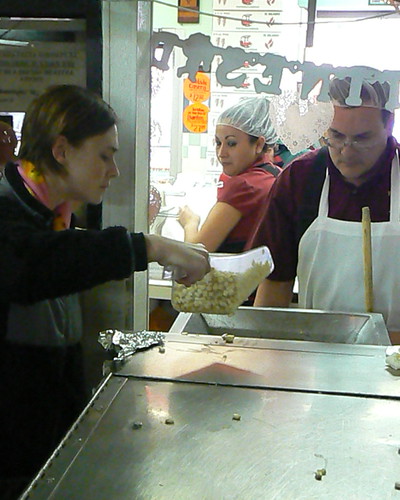
Masa is used for making corn tortillas or tamales. El Milagro also offeres Chicharrones, chips and tortillas, It(1923 S Blue Island Ave, Chicago) was a fun stop.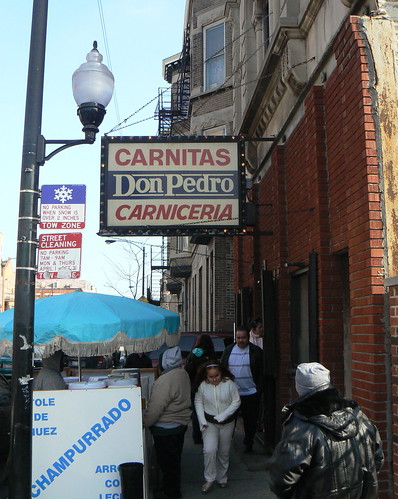
But what Tony really missed out on was Carnerceria Don Pedro. As the name implies, they sell carnitas either to eat in or to go. 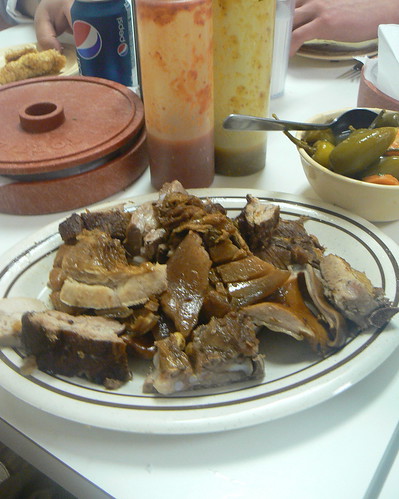
You don't really need a menu because all they serve is carnitas, or if you are not feeling porcine, barbacoa of goat. 
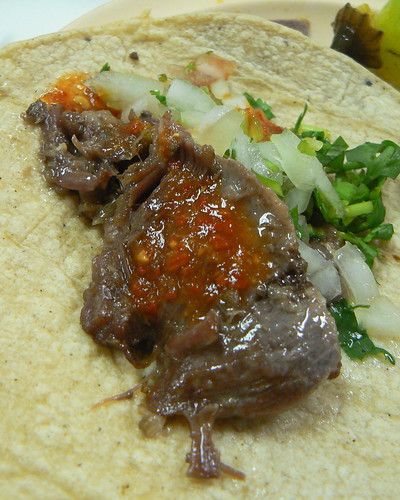
We were served family style with sides chicharrones and jalapenoes escabeche. Chef showed us the proper taco: Some carnitas, crushed chicharrones, onion, cilantro, a squirt of sauce and a squeeze of lime. After lunch Don Pedro showed us the kitchen. 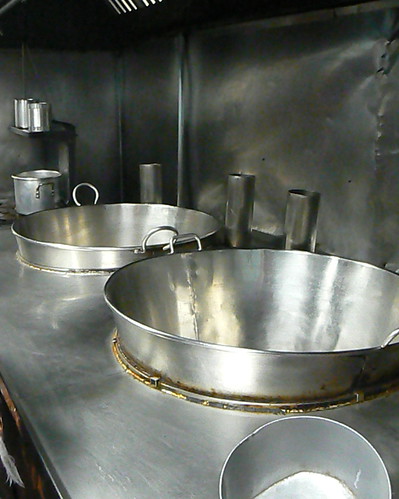

We saw huge kettles where they cook the pork in lard. That right, carnitas are pork confit. Recently I have been reading a lot about chefs getting whole hogs and breaking them down themselves, and making a menu of "nose to tail" dishes. Don Pedro said he goes though fifty whole hogs in a weekend. 
He also makes head cheese and long ropes of sausage. It's nose to tail eating on the cheap. The business there is swift on the weekends with the carryout crowd jamming the front of the room, A man in behind the counter chops at the carnitas in a digit removing fashion, and packs to go orders by the pound. There are maybe ten tables for eating in. And don't show up late, at least not on Sunday. We got there at 1:15 and we got the last of the barbacoa, and they were down to their last tray of carnitas.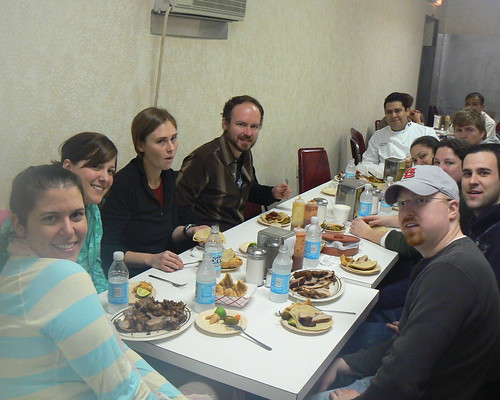
Carnerceria Don Pedro
1113 W 18th ST
Chicago
312-829-4757
Cash Only
Small parking lot just west of the building.
So come visit the Southside. We got more than just grit.
Cheers.
Posted by mac at 21:53 5 comments
Labels: Anthony Bourdain, Calumet Fisheries, Carnitas, Chicago, Culinary school, No Reservations, Southland
01 February, 2009
Seafood Sausage Choucroute
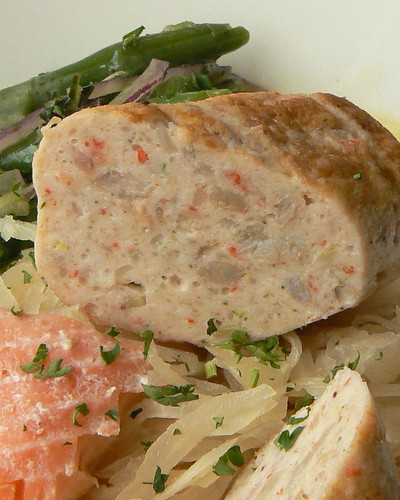
Wish I was a Kellogg's Cornflake
Floatin' in my bowl takin' movies,
Relaxin' awhile, livin' in style,
Talkin' to a raisin who 'casion'ly plays L.A.,
Casually glancing at his toupee.
Wish I was an English muffin
'Bout to make the most out of a toaster.
I'd ease myself down,
Comin' up brown.
I prefer boysenberry
More than any ordinary jam.
I'm a "Citizens for Boysenberry Jam" fan.
Ah, South California...
from Punky's Dilemma, Simon and Garfunkel
Indeed.
I remember hearing this song years ago, its words set the scene, I imagine myself floating in Hockney colors without a worry in the world. A couple of weeks ago we took a trip to South California (Northern San Diego County to be exact)and the scene surpassed our imaginations: Fish tacos, beer and the beach, our winter was warmed. For the trip back, Bonne Femme bought me a Sunset Magazine. At first I snickered thinking of the stacks of old Sunset Publications on the book sale racks at the library. But wait, this mag is kinda good, a hip Better Homes and Gardens, or a Real Simple with a sense of place (and purpose). On the plane I got intrigued by a recipe for Wine Braised Seafood Choucroute. It hits some of my favorite flavor points, Sauerkraut, smoked fish and sausage. It's party time.
A word about Choucroute.
Chou is French for cabbage. Choucroute is French salted cabbage or as my German pals say, Sauerkraut. Choucroute a L'Alsacienne is the comfort food of the Alsace region in which sausages, smoked meats, maybe confits de goose or duck are braised cabbage with a wine broth. But will this work with seafood?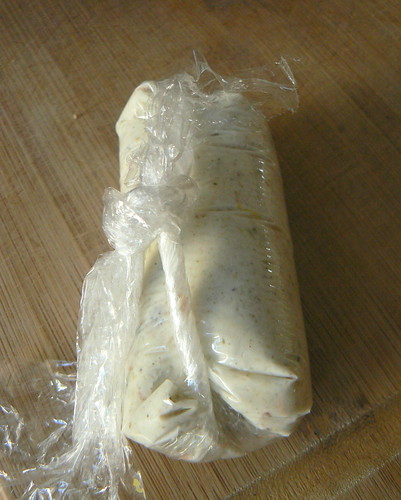
Quenelles.
For the seafood sausage I skip the "gourmet" markets the magazine suggests and turn to Ruhlman and Polcyn's Charcuterie, for a recipe. The Shrimp, Lobster and Leek sausage seems like a good start. As I am reading it I start ruminating about how seafood and sausage really don't go together: The ingredients are expensive and highly perishable, and stuffing a fish mixture into a hog or sheep casing really knocks my Feng Shui out of whack. I look around for other seafood "sausage" recipes, the French must have done something like it. Well they did, only they don't call it sausage. The secret term that links the Charcuterie recipe to culinary history is mousseline forcemeat. Escoffier defines the mousseline forcemeat as preparation of pounded meat whipped together with egg whites and heavy cream. Form this mixture using a spoon, pastry bag, or just rolling it, and you get quenelles. Thems fish balls, yo.
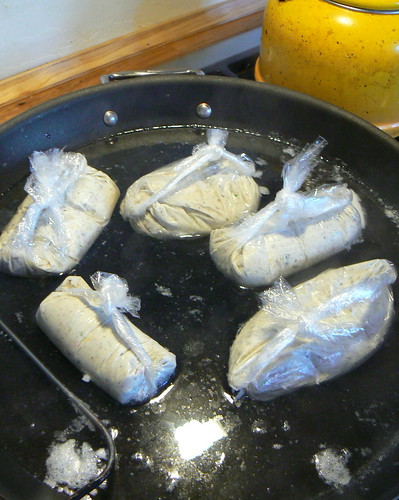
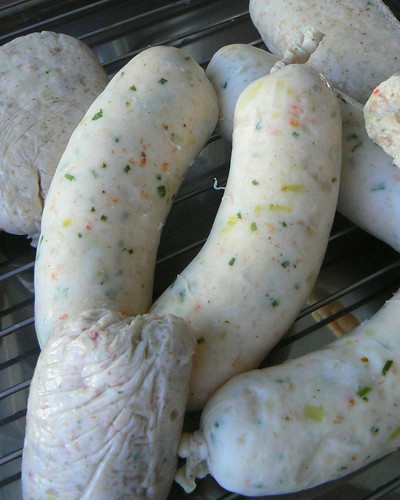
I ended up doing two batches because the recipe only made four 4-1/2oz sausages. The first batch I stuffed into hog casings the second batch I poached in plastic. I used crab instead of lobster.
Braising liquid.
I saved the shrimp shells and sauteed them with a mirepoix of onion, fennel and parsnip. I added a package of bonito flakes for a little extra zip. The addition of wine turns the stock into what pros call a fumet, and Hey Presto, you got yourself a braising liquid for your choucroute.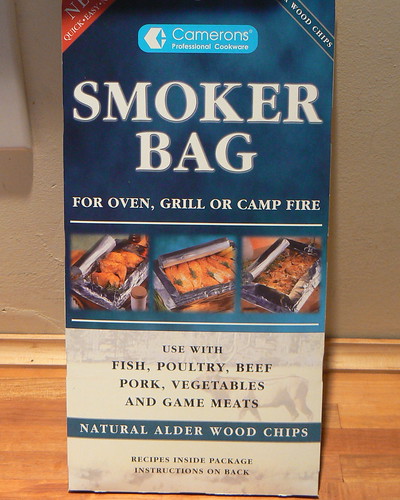
Smoking Fish in the comfort of your home.
I laughed when I first saw these smoker bags at Walt's, I mean what kind of cockamaime tomfoolery is somebody to to foist on me? But when I discovered that these bags were made in Finland, I loaded up. Seriously what the Finns DON'T know about smoking, aint worth knowing. I went to this farmer's market over there where these dudes were selling hams that they had smoked in their Sauna. I gotta get me a sauna.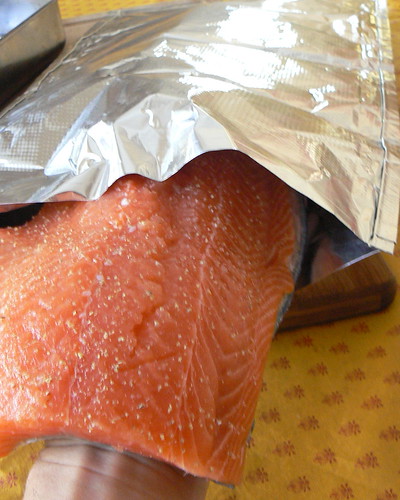
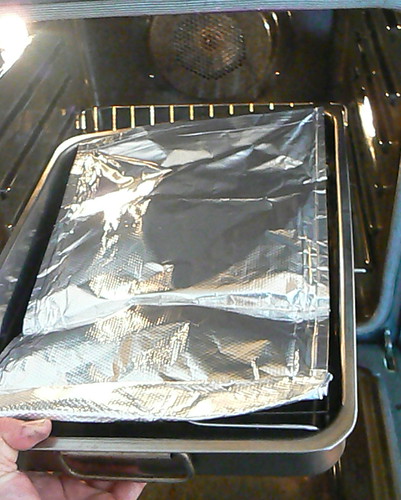
Anyway I loaded the about pound and a half of salmon into the bag folded it shut, and popped it into the oven. I could smell the smoke working, but it wasn't a nuisance. It didn't even come close to setting off a smoke alarm.
20 minutes later I had hot smoked fish. As you can see it's not very pretty and a little undercooked, but that's okay it will finish cooking when we do the braise.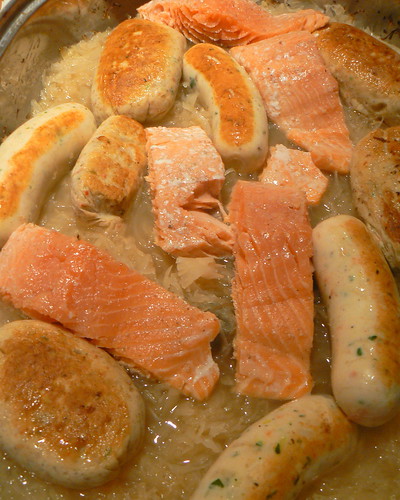
I followed the Sunset recipe and braised the cabbage in the fumet along with some garlic and a sachet containing juniper, thyme, bay leaves and peppercorns. After an hour I added the smoked salmon and the quenelles. I browned the quenelles before adding them. Heat and serve. Everything was delicious and worth the fuss. Here's the recipe I used for the seafood "sausage."
Shrimp and Crab Sausage (Quenelles)
1lb/450 g large (16-20 ct) Shrimp peeled deveined.
8 g (1 teaspoon) salt
2 g ground white pepper
1 large egg white
100-150 ml heavy cream
2 g dry tarragon
50 g leeks, chopped fine, blanched
55 g crab (whatever you can afford)
Use a food processor puree shrimp with salt pepper and egg white. With machine running add heavy cream, keep an eye on the mixture you don't want it to get too loose. And make sure everything stays very cold. Transfer to a bowl and fold in remaining ingredients. Chill. Stuff into casings or roll in plastic then gently poach until done.
I adapted this recipe from Charcuterie with input from Escoffier and Larousse.
Cheers.
Posted by mac at 13:42 10 comments
Labels: Fish, French Cooking, Quenelles, Seafood Sausage, Smoking

